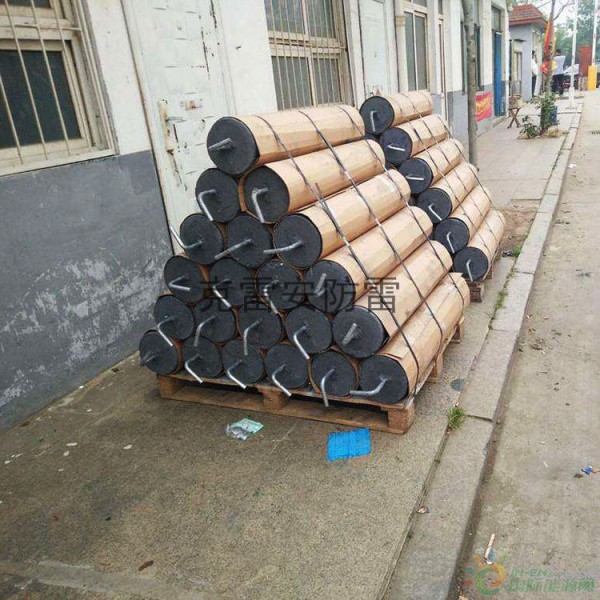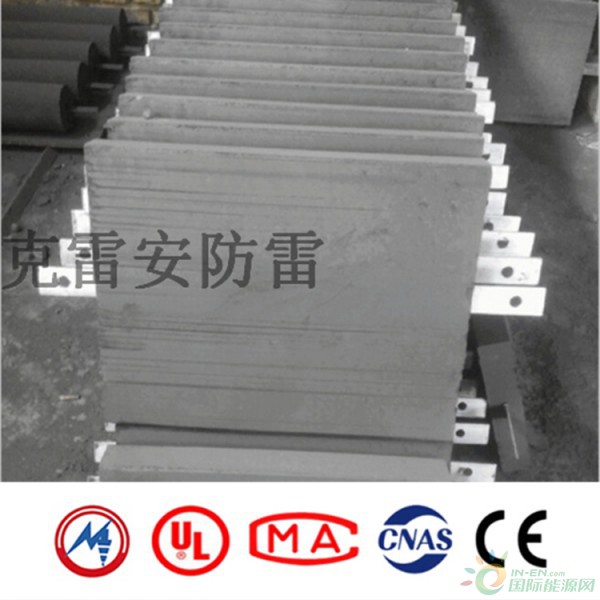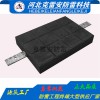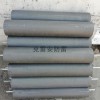电力防雷专用石墨接地模块接地极生产厂家规格型号大全
石墨接地模块技术参数
|
外型
|
型号
|
外型尺寸(mm)
|
电极规格及长度(mm)
|
重量(kg)
|
|
方型
模块
|
KLA_HX500F
|
500×400×60
|
镀锌扁钢,-40×4×740
|
20
|
|
KLA_HX600F
|
600×400×60
|
镀锌扁钢,-40×4×840
|
24
|
|
圆柱型
模块
|
KLA_HX1508F
|
Φ150×800
|
铜包(或镀锌)圆钢,Φ12×1100
|
30
|
|
KLA_HX1510F
|
Φ150×1000
|
镀锌钢管,Φ18×1300
|
35
|
|
KLA_HX1508M
|
Φ150×800
|
铜包(或镀锌)圆钢,Φ12×1100
|
25
|
|
梅花型
模块
|
KLA_HX1510M
|
Φ150×1000
|
镀锌钢管,Φ18×1300
|
30
|
|
KLA_HX2008M
|
Φ200×800
|
镀锌钢管,Φ26×1100
|
35
|
|
KLA_HX2010M
|
Φ200×1000
|
镀锌钢管,Φ26×1300
|
40
|
|
KLA_HX2613M
|
Φ200×1300
|
镀锌钢管,Φ26×1600
|
52
|
非金属接地模块简介
非金属接地模块在通讯、广电等部门有广泛应用。它是由导电能力优越的非金属复合材料加工成型的,加工方法有浇注成型和机械压模成型。一般来说浇注成型的结构松散、强度低、导电性能差,而且质量不稳定,一些小型厂家少量生产使用这样的办法;机械压模法,是使用设备在几到十几吨的压力下成型的,不仅尺寸精度较高、外观较好,更重要的是材料结构致密、电学性能好、抗大电流冲击能力强,质量也相当稳定,但是生产成本较高,批量生产多采用。选型时,尽量采用后者,特别是接地体有抗大电流或大冲击电流的要求(如电力工作地、防雷接地)时,不宜采用浇注成型的非金属接地体。非金属接地体是不受腐蚀的接地体,其稳定性、环境适应性、使用寿命都是现有接地材料中**的,不需要定期改造和维护。非金属接地体施工需要的地网面积比传统接地面积小很多,但是,在不同地质条件下,也需要保证足够的接地面积才可以达到良好的效果。
接地模块分类
石墨接地模块分为 三孔三棱型接地模块 三孔六棱型接地模块 实心六棱型接地模块 实心圆柱型接地模块 三梅花型接地模块 圆形接地模块 方形接地模块六种接地模块。
低电阻接地模块特性
1、降低接触电阻,主体材料与土壤的物理结构相似,能与土壤结合为一体,使接地体与土壤的有效接触面积比金属接地体大许多倍,增大了接地体的有效散流面积,极大降低接地体与土壤的接触电阻,因此能显著提高接地效率,减少地网占用土地面积。
2、接地电阻稳定:自身有很强的吸湿保湿能力,使它周围的土壤保持湿润,保证接地模块有效发挥导电作用;同时,接地体中导电物的导电特性不受干湿度、高低温等季节变化的影响,因此能提供稳定的接地电阻。
3、使用寿命长:主体本身是抗腐蚀材料,它的金属骨架采用的是表面经抗腐蚀处理的金属材料,可达到接地电阻≤4Ω的要求, 接地体长期保持稳定,其使用有效期大于30年.
4、其具有吸湿,保湿特性,能经受-40℃的低温,北方高寒地区同样适用. 由稳定性非常好的金属材料为主体,以表面经抗腐蚀处理的金属材料作骨架,通过专用设备挤压成型。
5、减少地电位反击:非金属材料使电阻率相差巨大的金属与土壤之间形成一个变化比较平缓的低电阻区域,当大电流冲击时,可降低接地体、接地线暂态电位梯度,降低跨步电压和接触电压,减少发生地电位反击的概率。
4)、对接地引下线要求接地引下线在地表交界段需全段涂刷2~3道环氧沥清漆、FVC漆或其他耐久漆,其地下段长度应使埋入降阻剂的部分不短于20mm,地表上面部分长度不短于30mm。
5)、深井接地深井接地有时是必需的。通常井深由找到电阻率低的地层或地下水来决定,一般达数十米。施工时用专用机械钻孔,孔径为80~150mm。有时要配以局部爆破,炸松四周土壤,以填充降阻剂,扩大降阻效果。接地电极用四壁上钻有Φ10~15mm通孔的钢管。用压力将调制好的降阻剂注入管内,通过壁孔使降阻剂从内外两侧包围钢管并充实整个
英文介绍
Introduction to non-metal grounding module
Non-metallic grounding modules are widely used in communications, broadcasting and other departments. It is formed by non-metallic composite materials with excellent electrical conductivity. The processing methods include casting molding and mechanical compression molding. In general, cast molding has loose structure, low strength, poor electrical conductivity, and unstable quality. Some small manufacturers use such a small amount of production; mechanical compression molding is formed by using equipment under a pressure of several to ten tons. Not only the dimensional accuracy is high, but the appearance is better. More importantly, the material structure is compact, the electrical performance is good, the resistance to large current surge is strong, and the quality is also quite stable, but the production cost is high, and mass production is adopted. When selecting the type, try to use the latter. Especially when the grounding body has the requirement of resisting large current or large inrush current (such as electric working place and lightning protection grounding), it is not suitable to use cast non-metallic grounding body. The non-metallic grounding body is a corrosion-free grounding body. Its stability, environmental adaptability and service life are the best among the existing grounding materials, and do not require regular modification and maintenance. The grounding area required for the construction of non-metallic grounding bodies is much smaller than the traditional grounding area. However, under different geological conditions, it is also necessary to ensure sufficient grounding area to achieve good results.
Grounding module classification
The graphite grounding module is divided into three-hole three-edge grounding module. Three-hole hexagonal grounding module Solid hexagonal grounding module Solid cylindrical grounding module Three plum-shaped grounding module Round grounding module Square grounding module Six kinds of grounding modules.
Low resistance grounding module characteristics
1. Reduce the contact resistance. The physical structure of the main material is similar to that of the soil. It can be integrated with the soil, so that the effective contact area between the grounding body and the soil is many times larger than that of the metal grounding body, which increases the effective area of the grounding body. Greatly reduce the contact resistance between the grounding body and the soil, so it can significantly improve the grounding efficiency and reduce the land area occupied by the grounding grid.
2, the grounding resistance is stable: it has a strong moisture absorption and moisturizing ability, so that the soil around it is kept moist, to ensure that the grounding module effectively exerts the conductive effect; at the same time, the conductive properties of the conductive material in the grounding body are not affected by the dry humidity, high and low temperature, etc. The effect of the change, therefore, provides a stable grounding resistance.
3. Long service life: The main body itself is anti-corrosion material. Its metal skeleton is made of metal material with anti-corrosion treatment on the surface, which can meet the requirement of grounding resistance ≤ 4Ω. The grounding body is stable for a long time, and its use period is more than 30 years. .
4, it has moisture absorption, moisturizing properties, can withstand the low temperature of -40 ° C, the same applies to the northern cold regions. From the metal material with very good stability as the main body, the metal material with anti-corrosion treatment on the surface as a skeleton, squeezed by special equipment Compression molding.
5. Reducing the ground potential counterattack: Non-metallic materials form a low-resistance region with a relatively gentle change between the metal and the soil with a large difference in resistivity. When a large current strikes, the transient potential gradient of the grounding body and the grounding line can be lowered and reduced. The step voltage and the contact voltage reduce the probability of a ground potential counterattack.
4). Grounding down the line is required. Grounding down the line. At the junction of the surface, it is necessary to apply 2~3 times of epoxy asphalt varnish, FVC paint or other durable paint. The length of the underground section should be the part of the buried drag reducing agent. Not less than 20mm, the length of the upper part of the earth's surface is not shorter than 30mm.
5) Deep well grounding Deep well grounding is sometimes necessary. Usually the depth of the well is determined by finding a formation with low resistivity or groundwater, typically tens of meters. Drilling with special machinery during construction, the hole diameter is 80 ~ 150mm. Sometimes it is accompanied by partial blasting, which loosens the surrounding soil to fill the resistance reducing agent and expand the resistance reduction effect. The grounding electrode is drilled with a steel pipe having a through hole of Φ10 to 15 mm on the four walls. The prepared pressure reducing agent is injected into the tube by pressure, and the resistance reducing agent surrounds the steel pipe from the inner and outer sides through the wall hole and enriches the whole






